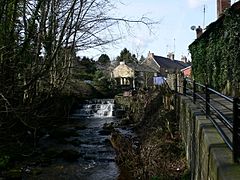River Eitha facts for kids
Quick facts for kids River Eitha |
|
|---|---|

The Eitha as it passes through Ruabon
|
|
| Native name | Afon Eitha |
| Country | Wales |
| Physical characteristics | |
| Main source | Ruabon Moors, Wrexham County Borough 430 m (1,410 ft) 53°0′27.755″N 3°7′57.397″W / 53.00770972°N 3.13261028°W |
| River mouth | confluence with River Dee, Wrexham County Borough 50 m (160 ft) 52°57′42.450″N 3°2′31.494″W / 52.96179167°N 3.04208167°W |
The River Eitha (called Afon Eitha in Welsh) is a small river. You can find it in the Wrexham County Borough area of Wales. It flows into the larger River Dee. The name "Eitha" probably comes from a Welsh word, eithaf. This word means "extremity" or "farthest."
Long ago, people believed the River Eitha was part of an important border. A famous historian, Sir Cyril Fox, studied old earthworks like Offa's Dyke. He thought a part of the Eitha helped mark the edge of an old kingdom called Mercia.
Contents
The Journey of the River Eitha
The River Eitha starts its journey high up on the Ruabon Moors. This area is known as Newtown Mountain. Here, it is called the Trefechan Brook.
From Moors to Reservoirs
The river then flows through a steep valley. It reaches two reservoirs above Penycae. At this point, the Eitha is very important. It helps supply water for Dee Valley Water, which used to be Wrexham Water.
Joining Other Streams
In Penycae, another stream joins the Eitha. This stream is called Nant y Crogfyn. It also flows down from the slopes of Ruabon Mountain.
Flowing Through Villages
After Penycae, the Eitha flows towards the south-east. It passes through the village of Ruabon. In the past, people used the river's power here. It helped run several watermills in the village.
Reaching the River Dee
From Ruabon, the Eitha continues south. It goes through a deep, wooded valley. This valley is part of the beautiful Wynnstay Estate. Finally, the River Eitha joins the River Dee near Chirk.

